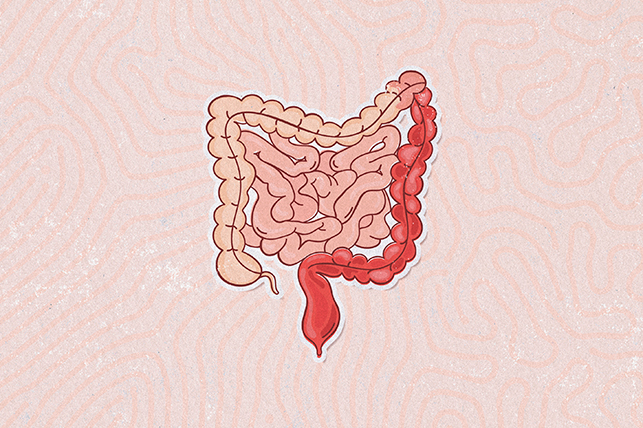The Causes and Stages of Inflammatory Bowel Disease

Inflammatory bowel disease (IBD) affects about 6 million to 8 million people worldwide. The Centers for Disease Control and Prevention (CDC) estimates that 1.3 percent of adults in the United States, roughly 3 million people, have been diagnosed with IBD. Additionally, a 2020 study in the Lancet Gastroenterology & Hepatology research journal indicated the highest prevalence rate for IBD patients is in the U.S.
IBD affects your physical and mental health, and your sexual health. Although there's no reason IBD patients cannot be intimate, the course of the disease, medication and possible surgery necessary for some people—as well as the general symptoms—can certainly slow the desire to have sex.
Certain disease symptoms, medications and surgeries affect libido and can potentially cause erectile dysfunction (ED) in men.
Research is sparse, but it's estimated by the Crohn's & Colitis Foundation that about 40 percent of IBD patients report the disease has prevented them from forming intimate relationships. Almost 70 percent of IBD patients claim they have body image problems. Sexual dysfunction is reported by 52 percent of women and 20 percent of men with IBD.
How do you get IBD?
In general, IBD seems to be more prevalent in developed countries, and no one really knows the exact reason ewor even how IBD develops.
"The exact cause of IBD isn't known, but what is known is that it is the result of immune system deficiency. Studies show that the disease develops because of complex interactions between the immune system, microbiota and the environment in genetically susceptible individuals," said Jelena Vulevic, a gut microbiologist in the United Kingdom with 20 years of experience. She and her business partner George Tzortzis, a biotechnologist, funded veMico, a biotechnology research company, and created The Y Collection, a variety of microbiome-derived nutraceuticals they describe as the next generation of gut supplements.
"The microbiota in this case plays a significant role because it is implicated in the initiation, progression, symptom severity and even the response to treatment options," Vulevic added. "This should not be surprising given its tight connection in the management and function of the immune system and the [gastrointestinal tract] inflammation throughout our life."
Vulevic cited a number of factors that can trigger an IBD flare: stress, air pollution, smoking, vitamin D deficiency and overuse or reliance on antibiotics. Triggers can include certain foods and drinks, such as spicy or fatty foods, carbonated drinks, alcohol, caffeine, raw vegetables and fruits, processed meat and types of insoluble fiber, such as ones found in whole grains.
Our digestive system is already a habitat for bacteria and microorganisms. In generally healthy people, a mutually beneficial relationship occurs between humans and gut bacteria; the microbiota in the gastrointestinal tract typically helps people break down food.
Researchers are still searching for the exact etiology or cause of IBD. Many researchers believe it results from a genetic predisposition and an error in the immune response toward gut flora. This dysregulation of the microbiota in our guts is called dysbiosis. Research on the use of prebiotics or probiotics for the regulation of gut bacteria and treatment of IBD show promise but remains in the early stages.
Who's most at risk?
Some people are at a higher risk for IBD than others, but the most vulnerable patients are small children.
The general risks of developing IBD include age, family history, ethnicity and cigarette smoking, but age is the top risk factor for developing IBD, noted Inna Melamed, Pharm.D., a functional medicine practitioner and gut and hormones expert in New Jersey, and bestselling author of "Crohn's and Colitis Fix" and "Digestive Reset."
"We know that most diagnosed patients with IBD are adolescents ages 15 to 25," Melamed said. "The most vulnerable patients with IBD are small children since the disease can stunt their growth, and medications can potentially cause side effects and bone growth problems. It is also more difficult to medicate very small children with potent medications since the risks of adverse effects may be higher. Also, the risk of the disease may disable the younger population, even socially, [such as] risks of missing a lot of school, embarrassing aspects of having to run to the bathroom often in school as well as limited nutritional aspects."
Types of IBD
Between the mouth, where food comes into the body, and the anus, where waste comes out, we have the gastrointestinal tract or the GI tract. IBD causes swelling, sores and pain along the hollow organs of the GI tract.
There are two main forms of IBD, usually characterized by the location in which the inflammation appears:
- Crohn's disease. Causes swelling in any area of the GI tract, most often the small intestine and upper large intestine.
- Ulcerative colitis. Results in swelling and sores along the colon and rectum (parts of the large intestine).
These primary forms of IBD have certain characteristics that help differentiate them. Crohn's disease typically manifests in the small intestine near the connection with the large intestine. But it can cause inflammation in any part of the GI tract.
Ulcerative colitis is exclusive to the large intestine. Unlike Crohn's disease, ulcerative colitis tends to impact each individual in a variety of ways, depending on the severity of the inflammation and the location within the colon or rectum.
The appearance of the inflammation resulting from each form of IBD is another way to differentiate between the two conditions. In Crohn's disease, the damage is typically more scattered, where healthy tissue is mixed between the patches of inflammation spread across an area along the GI tract. On the other hand, ulcerative colitis has a more uniform distribution of inflammation, with little to no healthy tissues between damaged ones.
Another notable difference between these conditions is the depth of inflammation. Crohn's disease is known for causing certain complications not typically shared with ulcerative colitis.
A good example is the potential appearance of a fistula, a type of "tunnel" that forms between two organs, or between one organ and the surface of the skin. Crohn's disease can cause inflammation at a greater depth and is not just limited to the walls of the GI tract, which makes it easier for fistulas to form. In fact, experts claim about half of all people with Crohn's develop a fistula at some point, and the most common is called an anal fistula, a tunnel between the anal canal and the skin on your butt.
According to the Crohn's & Colitis Foundation in the U.K., 33 percent of people with Crohn's develop fistulas, while only 3 percent of ulcerative colitis patients share the same fate. This is because the inflammation caused by ulcerative colitis affects only the inner lining of the large intestine, unlike Crohn's.
Making a definitive diagnosis of Crohn's or ulcerative colitis isn't always straightforward. In some cases, a fistula may appear before diagnosis, becoming a strong indicator that a patient has Crohn's rather than ulcerative colitis.
However, telling the two conditions apart is not always easy. According to researchers, about 10 percent to 15 percent of patients are classified as having indeterminate colitis. This diagnosis is typically reserved for when there is difficulty making a concrete judgment, but most patients with indeterminate colitis later evolve to a more definitive diagnosis for either Crohn's or ulcerative colitis upon follow-up.
Since ulcerative colitis appears as a uniform inflammation spread across the large intestine, the most common diagnostic tool for this condition is a colonoscopy. While invasive, it allows your doctor or gastroenterologist to properly examine the colon and collect sample tissue for colonic biopsy. On the other hand, diagnosing Crohn's may be a little more complicated because its resulting inflammation could appear anywhere along the GI tract. Your doctor could suggest different scans and procedures depending on the suspected site of inflammation.
Although both Crohn's and ulcerative colitis are lifelong conditions, a variety of treatment methods or therapies are available to keep the inflammation and symptoms under control. Your doctors can prescribe various medications and treatment options to manage symptoms and get the disease under remission for both forms of IBD to avoid flare-ups.
In many cases, especially with older IBD patients, medications and treatment therapies may no longer be sufficient. In such instances, your doctor might suggest surgery, but this is typically reserved for severe, unresponsive cases.
"It is a lifelong condition with no cure, so the treatment options rely on the management of symptoms or the reduction of GI inflammation, which is the main reason for the disease," Vulevic explained. "It is very important that IBD is managed properly because prolonged periods with active disease and severe symptoms cause damage to the intestinal tissue beyond repair, eventually requiring surgical removal. They also predispose to colorectal cancer and other complications, for example, anemia, kidney stones, osteoporosis, arthritis, skin conditions, liver diseases, etcetera."
Stages of IBD
There are different stages of IBD, and symptoms can vary from one person to the next.
"The stages of IBD vary for each person," said Beata Rydyger, a registered nutritionist based in Los Angeles and clinical nutritional advisor to Zen Nutrients. "Symptoms may range from mild to moderate to severe, and can change over time. For example, patients with Crohn's can go through times when the disease is controlled, where there are few or no symptoms or times of active disease that causes flare-ups."
Karine Patel, a registered dietitian, nutritionist and founder of Dietitian Fit & Co in the U.K., shared that people with IBD often experience ups and downs with certain symptoms.
"The stages of IBD range from mild to severe as well," she added. "With mild IBD, symptoms like diarrhea or abdominal pain are common. In severe cases, [during] a flare-up period, frequent diarrhea, sharp abdominal pain, blood and mucus in stools, fever, iron deficiency anemia, waking up at night to go to the toilet, fatigue, joint pain and bloating are common symptoms."
How about validated specifications?
Melamed explained there are no validated specifications derived from a consensus to determine mild to moderate to severe disease.
Researchers and healthcare professionals generally consult the Crohn's Disease Activity Index (CDAI), which takes into account many different factors—weight, number of bathroom trips, abdominal pain, drug use, abdominal mass, hematocrit levels (the percentage of red cells in your blood), symptoms, fever and so on—to quantify the symptoms and status of the condition.
Here's a breakdown of the index scores:
- Less than 2.8 indicates remission
- 2.8 to 10 indicates low or mild disease activity
- 10 to 22 indicates moderate disease activity
- Above 22 indicates high or severe disease activity
Melamed added that there are epidemiological stages of IBD as well:
- Preclinical (not noted, microscopic inflammation)
- Diagnosed (symptoms and/or ulcerations)
- Consequence of the disease (poor quality of life, intestinal damage, surgery, etc.)
- Goals to improve (with the absence of ulcerations)


















